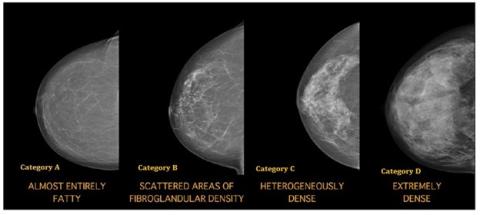Breasts are made up fatty tissue and fibroglandular tissue also known as dense tissue. The fibroglandular tissue includes milk glands, ducts, and supportive tissue. The amount of dense tissue compared to the amount of fatty tissue is referred to as your breast density. Density is not related to the size or firmness of a person’s breast—breast density can only be determined by a mammogram. Dense breast tissue is normal and very common and usually decreases with age.
Why is breast density important to know?
Since both normal dense breast tissue and cancers appear as white in an X-ray, cancers are sometimes hidden on a mammogram. Having higher breast density is associated with a higher risk for developing breast cancer, but having even the highest breast density does not mean someone will develop breast cancer. Breast density alone has a small impact on a person’s overall risk—being a woman, and increasing age, are the biggest risk factors.
Risk Factors
It is important to understand your overall risk for breast cancer. Having dense breast tissue on its own does not mean that you are at high risk for developing breast cancer in your lifetime. It also does not mean you are guaranteed to be diagnosed with breast cancer or that you may have a worse outcome than someone with less dense breasts.
Density should be considered in combination with other risk factors such as age, family history, genetic variants, and reproductive history. Take steps to reduce your modifiable breast cancer risk factors such as maintaining a healthy body weight, be active, and limit alcohol intake. If you are concerned about your risk, we recommend a breast cancer risk assessment using one of the recognized risk models. You can access more information about risk models and eligibility for high-risk screening in Nova Scotia here.
Breast density notification In Nova Scotia
Breast density is reported according to the American College of Radiology Breast Imaging Reporting and Data System (BI-RADS) standard. There are four categories of breast density, shown below as they appear on a mammogram.

|
Categories |
Explanation |
Breast Density Distribution in Screened Population ages 40-74 (2025 data) |
|
A |
The breast tissue is almost entirely made up of fatty tissue. |
35% |
|
B |
The breast tissue is mainly made up of fatty tissue, with some small areas of fibroglandular (dense) tissue. |
39% |
|
C |
The breast tissue has a mix of fatty and fibroglandular (dense) tissue. |
17% |
|
D |
The breast tissue is almost entirely made up of fibroglandular (dense) tissue. |
9% |
In Nova Scotia breast density is assessed by software and automatically included in every screening results letter sent directly to clients.
Important to know
- Screening mammography continues to be the best test to detect breast cancer and reduce stage of diagnosis in average-risk individuals with no symptoms. It can detect many breast cancers before symptoms occur, even in those with the densest breasts.
- Many individuals who do not have dense breasts can develop breast cancer. It’s important to get a screening mammogram regularly, as this is the only test proven to find cancer when it’s small, allowing more treatment options and better chance of recovery. Being screened at your recommended interval is important for mammography to be most effective, as it allows the radiologist to look for subtle changes over time.
- Breast density can change between visits.
- Density tends to go down as you age but may also be affected by taking hormone replacements, weight gain or loss, and menopausal status.
- Regardless of breast density, mammography will not detect all breast cancers. It is important for people to be aware of the normal look and feel of their breasts, and have any breast changes investigated by a health care provider, even if you have had a normal mammogram. To learn more about signs and symptoms, visit our breast health page.
- Understand your overall risk for breast cancer. Having dense breast tissue on its own does not mean that you are at high risk for developing breast cancer in your lifetime. Take steps to reduce your modifiable breast cancer risk factors such as maintaining a healthy body weight, be active, and limit alcohol intake. Visit our high-risk screening page for information on eligibility criteria and risk assessment.
- Knowing your breast density is part of your overall breast health. It is valuable information for individuals to understand how effective mammography may be for them.
- Nova Scotia Breast Screening Program does not offer additional screening for individuals with dense breasts as part of our population health screening program.
- If your density is category D, you will be recalled for annual screening mammography.